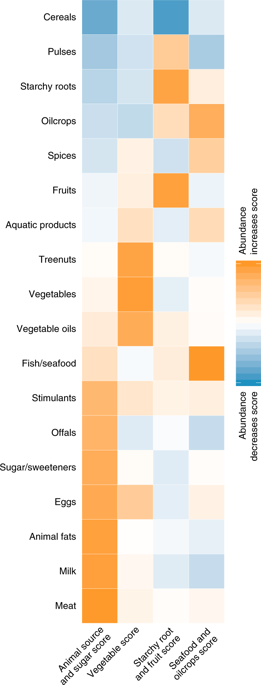Nature Food ( IF 23.6 ) Pub Date : 2020-01-13 , DOI: 10.1038/s43016-019-0012-2 James Bentham 1 , Gitanjali M Singh 2 , Goodarz Danaei 3, 4 , Rosemary Green 5, 6 , John K Lin 7, 8 , Gretchen A Stevens 9 , Farshad Farzadfar 10 , James E Bennett 11, 12, 13 , Mariachiara Di Cesare 14 , Alan D Dangour 5, 6 , Majid Ezzati 11, 12, 13, 15

|
Food systems are increasingly globalized and interdependent, and diets around the world are changing. Characterization of national food supplies and how they have changed can inform food policies that ensure national food security, support access to healthy diets and enhance environmental sustainability. Here we analysed data for 171 countries on the availability of 18 food groups from the United Nations Food and Agriculture Organization to identify and track multidimensional food supply patterns from 1961 to 2013. Four predominant food-group combinations were identified that explained almost 90% of the cross-country variance in food supply: animal source and sugar, vegetable, starchy root and fruit, and seafood and oilcrops. South Korea, China and Taiwan experienced the largest changes in food supply over the past five decades, with animal source foods and sugar, vegetables and seafood and oilcrops all becoming more abundant components of the food supply. In contrast, in many Western countries the supply of animal source foods and sugar declined. Meanwhile, there was remarkably little change in the food supply in countries in the sub-Saharan Africa region. These changes led to a partial global convergence in the national supply of animal source foods and sugar, and a divergence in those of vegetables and of seafood and oilcrops. Our analysis generated a novel characterization of food supply that highlights the interdependence of multiple food types in national food systems. A better understanding of how these patterns have evolved and will continue to change is needed to support the delivery of healthy and sustainable food system policies.











































 京公网安备 11010802027423号
京公网安备 11010802027423号